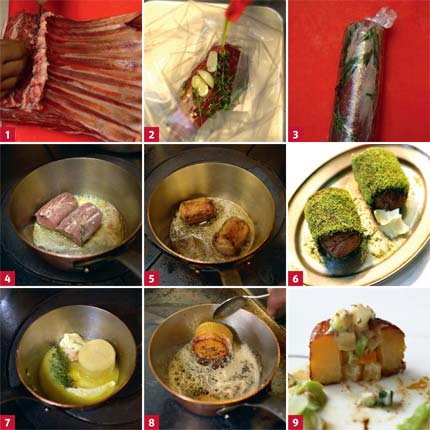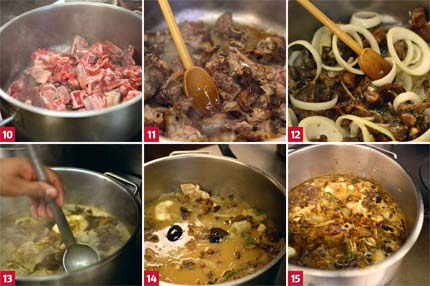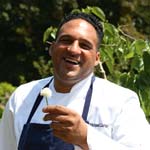Michael Caines masterclass – Dartmoor Lamb with jus gras
Michael Caines needn't travel far from Gidleigh Park in Devon to source great English lamb. To enhance its flavour, he uses a robust jus gras. Michael Raffael reports
Jus gras translates as "fatty juice". English chefs call it "split sauce". At its simplest it's the dripping and gravy in the bottom of a roasting tin. Lean cuts of meat don't produce very much and vac-packed portions cooked in water baths none. One of the basic tastes and one of the best is in danger of leaking out of the professional repertoire.
What makes it special? It captures the essence of a basted roast. It's both mouth-watering and persistent - the flavour stays in the mouth for a long time after the food has been swallowed.
Sauce nowadays tends to be an add-on: foam, dab, drizzle, paint. Too often its role appears cosmetic. It may improve the look of a dish, but it doesn't stitch the whole thing together. Michael Caines' jus gras, served with Dartmoor lamb, does. Its quality enhances the meat. Its quantity, about two tablespoons, is enough but not too much; it doesn't drown the vegetables on the plate. Without it, the dish wouldn't look as pretty and would taste unfinished.
Dartmoor lamb in a herb crust, fennel puree and a ragout of seasonal vegetables
Basic Prep before starting
Herb and Dijon mustard pesto Blend 18g basil leaves, 4g fresh thyme leaves, 30g Dijon mustard and 30ml olive oil.
Provençal breadcrumbs
Blend 250g dried breadcrumbs, 125g parsley leaves, 12g garlic, 50ml olive oil, salt and white pepper to a fine crumb and sieve.
White chicken stock At Gidleigh Park the kitchen makes its basic stock from 25kg of chicken wings and 2kg of peeled, halved onions. Chefs fill the pan with just enough water to cover the bones, bring the liquid to boiling point and simmer it for six hours. Then they pass the stock through a colander and chill it, which sets it to a jelly.
There are two by-products: they use fat scraped off the top of the cold stock for cooking, and the reboiled bones make a light second stock.
LOW-TEMPERATURE COOKED LOIN OF LAMB
At Gidleigh Park the jus gras accompanies marinated loin of lamb, which is poached in a water bath. For the picture Michael Caines has used one best end for two portions, but his chefs would normally scale up the basic preparation for 10 to 12 servings.
Cut out the eye muscle (1) and put it in a transparent bag with thyme, rosemary, garlic and a little olive oil (2). Seal and leave for 24 hours.
Remove the lamb from the bag, and wrap tightly in film to form a "sausage" (3).
Place it in a fresh bag with sprigs of thyme, rosemary, a clove of garlic, salt and milled white pepper.
Seal and cook the lamb in a water bath at 55°C for 50 minutes. Refresh on ice. Store chilled.
VEAL GLACE
Ingredients 35kg veal rib bones
400g plain flour
300ml approx. neutral oil
4kg carrots, roughly chopped
3kg onion roughly chopped
3kg leeks roughly chopped
1.5kg celery stalks
750ml dry white wine
800g tomato paste
Method
Put the ribs into roasting tins. Roast in a hot oven, turning from time to time so the bones cook evenly. When they've started to caramelise sprinkle flour over them and finish cooking for a final 10 minutes. Transfer to the boiling pan.
Heat the oil in a large pan. Sweat the vegetables over a low flame without colouring. Add the wine, let it reduce by half and stir in the tomato paste. Take off the heat and set aside for 30 minutes. Add to the bones.
Cover with water (the result is better if the bones are just below the surface). Boil, skim and simmer for 48 hours.
Pass the liquid through a colander and reduce it in a clean pan to three litres.
Main dish
Ingredients (Serves one)
130g low temperature cooked lamb
Unsalted butter
Herb and mustard pesto
Provençal breadcrumbs
Reduced balsamic vinegar
Wilted baby spinach
Stuffed fondant potato
Fennel purée
Ragout of vegetables in a water-butter emulsion
1 braised baby fennel
Roast garlic clove
2-3tbs jus gras
Sage, chive and borage flowers
Method
Reheat the lamb in its sous vide package to 48°C (20 minutes). Take it out of the pack, remove the film, and fry in unsalted butter to colour on all sides. (4, 5). Brush it around the waist with herb and mustard pesto and then roll it in the breadcrumbs (6).
To serve
Pipe an "S" on to the plate with balsamic vinegar. Slice the meat into three pieces. Arrange it on the spinach. Lay the potato to one side. Spoon a little fennel purée on the plate. Fill a small hoop with the vegetables. Add the braised fennel and garlic. Spoon the jus on to the plate and finish with edible flowers.
Note: To prepare the fondant potato, colour a cylinder of steamed potato in butter (7, 8), hollow out the centre and fill with a farce made from sautéed lamb fillet and kidney, carrot and celery brunoise and reduced double cream (9).
JUS GRAS (for Lamb)
This recipe has evolved from one that Michael Caines learnt while working for Joel Robuchon in Paris as a chef de partie. There, sauces were made fresh daily.
His basic recipe requires 2.5kg lamb carcasses. He buys young Dartmoor lamb. The fat on older lamb or hogget would be too "tallowy". The carcasses shouldn't hang overlong.
Caines prefers bones and trimmings from the loins and best ends, chopped into pieces weighing less than 100g (10).
Equipment: a large, heavy-duty rondeau. For browning the lamb, the temperature should be approaching 200°C.
Ingredients (Makes about 2 litres - 40-50 portions)
500g large onions
1 large head of garlic
Sunflower oil to cover the base of the pan
2.5kg chopped lamb carcass and trimmings
400ml water
1.2 litres chicken stock
500ml veal glace
20 large sprigs of thyme
10g white peppercorns
Salt
Method
Peel the onions and cut them into large rings. (By doing them this way, they will rest on top of the meat and not scorch on the bottom of the pan.) Halve the garlic.
Heat the oil in the pan almost to smoking point. Add the lamb. Fry it until the fat renders and the bones caramelise. This shouldn't be hurried; it can take up to a quarter of an hour, turning the pieces from time to time (11).
When the bones start to colour lay the onion on top and add the garlic (12). Once they have softened, deglaze the pan with water. Add the jellied white chicken stock, veal glace, thyme and peppercorns.
When the liquid comes to the boil move it to a part of the solid top where it will boil gently. The stock and veal glace should just cover the bones. Skim off any scum that rises to the surface (13).
Move the pan to the side of the range and leave it to simmer for an hour. During this time don't skim off the fat that rises to the surface. Nor should you stir the pan, because the proteins in the lamb will let it clarify itself (14, 15).
Strain the sauce and fat through a colander and then a sieve into a clean pan, but don't force it through. Leave it to stand.
Reduce with a slow boil to required consistency, and season. Don't stir or whisk the sauce once it's ready or it may turn cloudy.
Michael Caines
Guided by Raymond Blanc, Joel Robuchon and the late Bernard Loiseau, Caines has a French background directing him and he's loyal to his roots. "Nobody," he insists "should be afraid to acknowledge classic training." Regardless of changing fashions, the skills it has taught him underpin his craft without stifling his creativity.
At Gidleigh, says Caines, the food has to complement the overall experience. "Cuisine in hotels can't be the same as in a 40 to 50-seater restaurant. Food here is related to comfort. Fine dining without butter or cream would be unthinkable. We have to be regional and seasonal." A maturing fruit and vegetable garden, allied to fresh produce from nearby Dartmoor, is what customers expect and what he delivers.
Old school values also include rigour and discipline. New technology, Caines admits, has helped chefs achieve higher levels of consistency. He makes the point though, that sous vide and water baths have been around for 30 years. One degree more or less on a thermostat isn't going to change a recipe that much.
The constant of all good cooking remains taste: "I don't want the theatre to mask great produce," says Caines. He concedes that it may matter as much to Heston Blumenthal as it does to him. What he fears is that those who copy The Fat Duck may mistake the froth for the substance. "I am working with my palate all the time, tasting sauces, ice-creams, smelling herbs, aromas from the stockpot and other such ingredients all day, always looking to improve and develop them," he says.
Science, he argues, has been a part of cooking for hundreds of years. The fundamentals: taste, texture, hot, cold haven't changed. Knowing where a cooking process is going is what matters: "Technique has to lead to a great flavour."
Gidleigh Park acts as a seedbed, nurturing young chefs who will run the kitchens at one of the growing number of ABodes. It's a template that has worked for star chefs since the days of the "Roux Babies". Caines is conscious of the role elitist restaurants play in shaping the industry. His day job creating mid-spend dining doesn't imply lowering standards.
Despite his numerous awards, Caines is still ambitious. He would still, more than anything else, love to win a third Michelin star.
Photography by Lisa Barber (www.lisabarber.co.uk)













